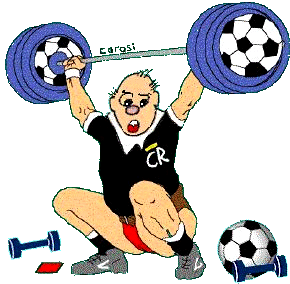| |
 |
IMPROVING YOUR FITNESS
Preparing and Training…
Andrew Castiglione
Founder of Ken Aston Referee Society
 |
Here are some suggestions for how you can improve your fitness to
Referee youth soccer. There are lots of other places where you can find
advice on how to improve your fitness. What's special about this one is
that it has very limited aims. It does not try to convince you of the
transcendent happiness of life long fitness; you will find no
exhortations here to strive for an "endorphin high" -- good though these
things may well be.
The aim is simply...
 - To help you get a little fitter, while
- To help you get a little fitter, while
 - Not getting hurt, and
- Not getting hurt, and
 - Suffering as little as possible...
- Suffering as little as possible...
We who wrote this advice (old, slow Referees who struggle to stay fit
enough to run with the teenagers) can identify with these aims because
they are our aims. What's written here has helped us. We hope it helps
you too.
If you already have an active fitness program, you'll probably think
that what is proposed here is unbelievably wimpy. That's fine. You don't
need this! Others will find the whole idea preposterous. "I'm supposed
to work out to prepare to volunteer in a children's recreation program?"
Well, that's OK too. But, however (much) you improve your fitness,
you'll Referee better and have a better time doing it. If these
suggestions help, that's great. Look at what's suggested here, do as
much as you can and as you enjoy doing, and ignore the rest.
The overriding concern is don't hurt yourself. There are a number of
suggestions made below about how to structure your workouts so as to
reduce the most common causes of injury (which are doing too much too
soon and doing it in dangerous ways and places). But even before that,
Consult your physician before starting this or any new program of exercise!
especially if you are over forty, and follow his or her recommendations
as to any limits or cautions you should observe. Only you can decide how
to adapt this or any other exercise regime to your specific
circumstances. Specifically,
Neither AYSO, USSF, Ken
Aston Referee Society nor any of its affiliated organizations,
sponsors, or volunteers, accepts any liability for any accidents,
injuries or other damages of any kind that may result from
following any or all of the suggestions given here.
The suggestions made here are just that, suggestions.
An individual exercise program must be an individual decision.
Design one that works for you, with whatever medical and other advice you deem appropriate.
The Laws of (getting fit for) 'The Game'...
Like everything else concerned with soccer refereeing, it turns out that
fitness can be covered in 17 "Laws". Like the other Laws, these should
be applied if (when, and as) "in the opinion of the referee" they are
appropriate. Trifling breaches should not be penalized.
1. Refereeing is running
You got to run! All that other exercise you get (aerobic arm wrestling,
etc.) is all good stuff. But to referee, you have to run. Although other
exercises work out some of the muscles needed for running, nothing gets
them all quite as well as... running.
2. But that shouldn't be all
Other exercise may not be enough by itself, but it sure helps. Including
some other kind of exercise allows you to keep up your fitness when you
can't run (e.g., when you're too sore, or during the winter when it's
dark too early). Choose something aerobic (puff! puff!) that you enjoy
and try and mix it in every third workout or so. Something of low impact
stress or that uses different muscle groups from running (e.g. swimming)
is great for when you're feeling sore. A workout machine in front of a
TV has the great benefit that it you can use the time to watch soccer
also!
3. Do it often
Exercising really hard only once a week is a good way to strain or pull
something (it's what referees who never work on their fitness do, and a
strain or a pull is, sooner or later, usually the result). Instead, try
to work out once every 2-3 days, with each session being at least as
long as one half of the games you plan to referee (e.g. 30 mins for a
referee working Under 12 games). Try to get in a routine (e.g. every
third day, or Mon-Wed-Sat). If you try to decide each day whether this
is a "workout day", the answer will too often be "NO!"
4. Gently!
Especially if you have not been running regularly recently, start gently
at first and slowly increase the effort level. This is even true
(perhaps especially true) if you "used to" work out a lot. Beware
"Busted Boomer" Syndrome: that unhappy fate of a 42 year old body with a
22 year old self image. Start by walking and stretching, move to "power"
walking, and then mix running and walking, one part running to two
walking at first, and then slowly move the balance to two or three to
one over time.
5. But not slowly
Don't jog. Run! Shuffling along at a snail's pace is something that you
never need to do on a soccer field, so don't practice doing it now.
Instead, alternate between running (at about half speed, as you would
following play) and walking (as you would when play is stopped or moving
slowly). Over time, as your fitness improves, shift the balance between
these.
6. Run out your front door
Some people enjoy running. You are not (yet) that kind of person (or you
wouldn't be reading this). We've suggested that you work out quite
often, so it's important that your workouts are as brief as possible, to
limit the total amount of time required. One way to waste a lot of time
is to drive somewhere (e.g. to some running track across town) to work
out and then drive back again when you're done. Your time's better spent
running, not traveling to run. So, unless your front door is in a major
urban area, or on the side of a cliff, start running the moment you
leave it.
You may wonder whether the hard surfaces of streets or pavements are
such good things to run on. We're going to do something about that in a
moment (see 7). That done, it's a tradeoff between the hard but reliable
smoothness of most road surfaces against the soft but unpredictable
roughness of most natural ones. In most cases, the convenience of the
pavement outside your door wins. But if you're more comfortable running
on grass, and there is a park nearby, by all means run over to it.
You may also worry at first that you're making a spectacle of yourself
in front of your neighbors. Not to worry! You'll soon be thinking about
other things (puff! puff!). The neighbors, if they notice you at all,
will have nothing but admiration (after all, they're not out there
getting fit, are they?). And the embarrassment of puffing past your
neighbor on the street is nothing compared to that of being lapped by
the local track team (or even worse, that triathlon running
grandmother!) on that shiny running track across town. Better to be by
yourself in your friendly local neighborhood.
7. In a new pair of good quality running shoes
These will make running on hard surfaces (like neighborhood streets, see
6) much pleasanter and safer. Also, when you're not running, they'll
make you feel really guilty about having spent all that money and not
using them, so you'll run more often (see 3).
8. To the sound of music
Some people really enjoy running. You are (still) not that kind of
person. Therefore, you will need some distraction, lest you focus too
much on feeling sorry for yourself. A portable cassette tape or CD
player with headphones is recommended. Loud rock music is very highly
recommended. It banishes feelings of embarrassment, physical inadequacy,
and self pity, as teenagers have long known. Besides, it will get you to
pick your feet up! Just remember that, since you can't hear what's going
on around you, you'll have to keep your head up and look around as you
run. This is not a bad habit for a referee to get into!
9. But not in the hills
Running in the hills makes for pleasanter scenery, a more strenuous
workout, and much greater impact stress on bones and joints
(particularly when running down the hill). If you must run in the hills
(e.g. the front door of your house is on a hill), try to walk or jog the
steeper sections and do your running on the flats.
10. Warm up
Just as for games, you should warm up before you work hard, to guard
against muscle pulls. How you do this is a very individual thing. Some
folks have elaborate stretching routines; others just jog slowly for a
few hundred yards. The Region's Referee's Handbook has a good set of
basic warm ups; as does the AYSO pamphlet Presence Lends Conviction. A
slow jog is the basic minimum.
11. S-t-r-e-c-h
If you never find yourself uncomfortably "tight" or sore after (or the
day after) running or refereeing, you can skip this. But, if you're like
everyone else, try adopting a routine of pre- and post-run stretching to
improve your flexibility. This helps distribute the impact stresses of
running more evenly and fluidly, so they do less tearing damage. (Hint:
Sometimes the thing you need to stretch is not the thing that's sore.
Instead, the problem may be something somewhere else that's too tense or
inflexible.) Bob Anderson's book "Stretching" has a great selection of
runner's stretches, along with stretches for almost any other activity
you can think of. A regular diet of post-game aspirin (ibuprofen, etc.)
is really not a good long term alternative.
12. Don't hurt yourself!
A sprained or even a strained muscle or joint can stop you training for
weeks or days, undoing in a moment much of what you've worked for. Don't
increase the intensity of your workouts suddenly, run hard without
warming up, run in traffic, or on steep or rough surfaces (especially in
poor light), or keep running when you have a sore or tight muscle.
13. If it hurts, stop!
Keeping going when you're tired is admirable. Keeping going when you're
hurt (any sharp pain), or exhausted, or showing any signs of major
physical distress (dizzy, faint, extreme or irregular pulse, etc.) is
very dangerous. Stop! If you can, continue at a walk. If you can't, or
if the problem does not rapidly clear up, consult your doctor. These
instructions are known as "the overriding conditions of Law 13".
14. Measure what you do
Keep track of what you're doing, by time or distance. Your subjective
sense of how well you're doing is very unreliable and it's easy to get
discouraged. If you regularly run a measured distance, it's easier to
keep going, and the continual small improvements will become visible,
which will encourage you. The easiest way is to measure a route near
your house (drive it a few times in your car and note the mileage). If
you run that route regularly, extending it slowly as you get fitter,
your progress will be clear to you.
One very useful measurement gadget is an athletic heart rate monitor.
These devices, available at any sports or running shoe store, allow you
to watch your pulse rate as you run, so you can make sure that it stays
high enough to do you good, but doesn't get so high that the level of
stress is unhealthy.
15. Variety for agility
All we have talked about so far is running in a straight line for
endurance. A modicum of endurance and general running strength is the
first thing to establish. But once that's done, it's time to add some
variety to more closely approximate what you do in a game. The first
step is to add some side stepping and running backwards to your regular
runs. Once or twice each time you run, while running with a clear, flat,
traffic free area for some distance in front of you, turn and run
backwards for 20 yards, turning back into a forward run at the end. Vary
this by turning into a side step, both left and right, in turn. Do this
slowly at first, it's easy to trip and fall until you get the hang of
it. Eventually, you should be able to do it without stopping or slowing
down at either turn. Then, once this is comfortable, try running the
agility run, starting at about 60% speed, and then slowly increasing the
speed as you get more agile.
16. Sprinting
Sprinting places extra demands on your muscles for strength and
resiliency, so the sudden extra load doesn't cause damage. Develop this
by running small sections (about 50-100 yards) of your regular run at
sprint speed. Transition to sprint speed by taking several short, sharp
steps; lengthening your stride as you build up speed. Slow down
carefully. Sprinting at top speed will feel a little unstable until you
have built up the muscle strength to control it. Once again, start out
at about 60% and only gradually increase the speed as you get more
control.
17. Stand up at the finish
At the end of each run or sprint, when you're tired, try to get in the
habit of not putting your hands on your hips while you recover. Instead,
hold your hands together behind your back. This doesn't feel nearly as
good, but it's better for you - it squares your shoulders and lets you
breathe more deeply. But, far more importantly, it makes you look good.
This won't matter on your neighborhood street, but come game time
everyone will admire how calm and in control you look, whereas if your
hands are on your hips and your shoulders are slumped over, they'll
think "Poor old ref!". After all this work, that is not the effect you
want!
Modify, adapt and vary.
Everything here is someone else's suggestion.
The most
important thing (other than not getting hurt) is that you keep going,
long after the novelty has worn off.
To that end, you need to find
things that work for you..........Experiment!
Add things that seem to help, drop
what you can without sliding back, give yourself little rewards for
passing milestones (literally).
The real rewards, of course, will come
on the field during the season, but anything that keeps you going until
then is worthwhile.
And if you do keep going, perhaps you might even one
day experience the transcendent happiness of life long fitness - you
never know.
|